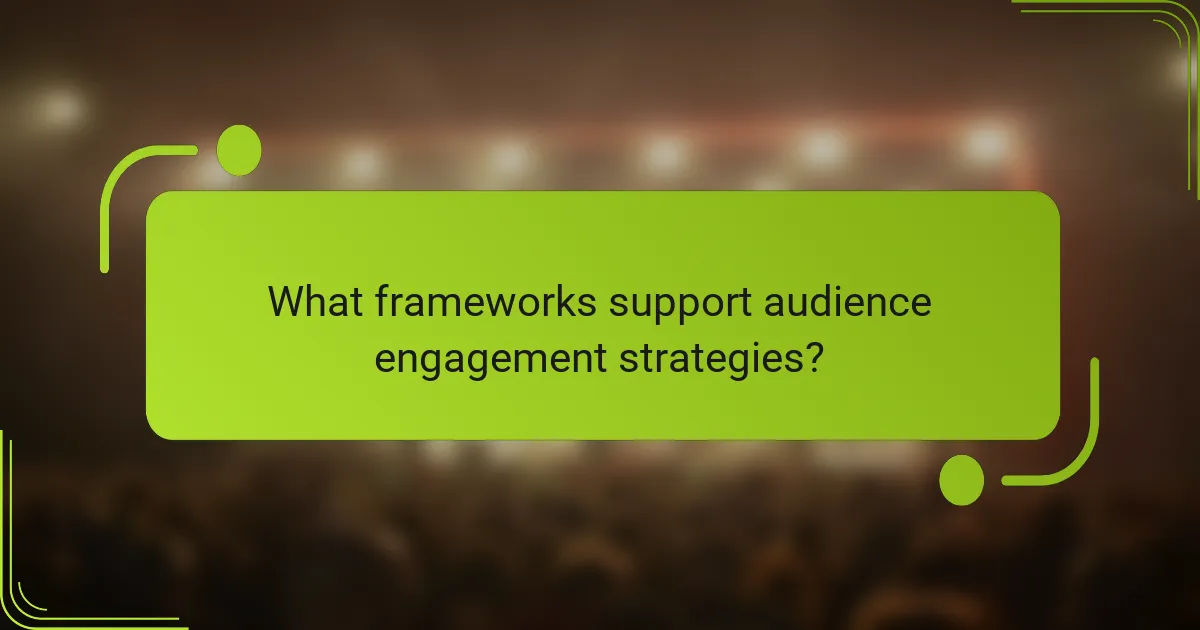Understanding audience engagement is crucial for businesses aiming to connect effectively with their target market. By tracking key metrics such as engagement rates, social media interactions, and website analytics, organizations can gain valuable insights into how their content resonates with users. Analyzing these trends over time allows for strategic refinements that enhance overall engagement and foster deeper connections with audiences.

How to measure audience engagement effectively?
Measuring audience engagement involves tracking various metrics that reflect how well your content resonates with your audience. Key indicators include engagement rate, net promoter score, customer satisfaction score, social media interactions, and website analytics.
Engagement rate
The engagement rate is a crucial metric that indicates the level of interaction your audience has with your content. It is typically calculated by dividing the total interactions (likes, shares, comments) by the total reach or impressions, then multiplying by 100 to get a percentage.
A healthy engagement rate varies by platform but generally falls between 1% to 5%. Aim for higher rates by creating compelling content that encourages audience participation.
Net promoter score
Net promoter score (NPS) measures customer loyalty and satisfaction by asking how likely customers are to recommend your brand to others, usually on a scale from 0 to 10. Responses categorize customers into promoters, passives, and detractors.
A good NPS is typically above 30, while scores above 50 indicate strong customer loyalty. Regularly survey your audience to track changes and identify areas for improvement.
Customer satisfaction score
Customer satisfaction score (CSAT) gauges how satisfied customers are with your products or services. It often involves a simple survey question asking customers to rate their satisfaction on a scale from 1 to 5 or 1 to 10.
Target a CSAT score of 80% or higher for a positive indicator of customer satisfaction. Use feedback to enhance your offerings and address any concerns promptly.
Social media interactions
Social media interactions include likes, shares, comments, and mentions across platforms like Facebook, Twitter, and Instagram. These metrics provide insight into how well your audience engages with your content on social media.
Monitor these interactions regularly to identify trends and successful content types. Aim to increase your interaction rates by posting consistently and engaging directly with your audience.
Website analytics
Website analytics track user behavior on your site, including page views, time spent on pages, and bounce rates. Tools like Google Analytics provide valuable insights into how visitors interact with your content.
Focus on metrics such as average session duration and pages per session to understand engagement levels. Use this data to optimize your website and improve user experience, aiming for lower bounce rates and longer visit durations.

What are the key audience engagement metrics?
Key audience engagement metrics help evaluate how effectively content resonates with users. Understanding these metrics allows businesses to refine their strategies and improve overall engagement.
Click-through rate
Click-through rate (CTR) measures the percentage of users who click on a specific link compared to the total number of users who view the content. A higher CTR indicates that the content is compelling and encourages users to take action.
To improve CTR, focus on creating engaging headlines and clear calls to action. Typical CTRs can vary widely by industry, but a range of 2-5% is often considered average for digital marketing campaigns.
Conversion rate
Conversion rate refers to the percentage of users who complete a desired action, such as making a purchase or signing up for a newsletter. This metric is crucial for assessing the effectiveness of marketing efforts.
To enhance conversion rates, ensure that landing pages are optimized for user experience and that the value proposition is clear. A conversion rate of 1-3% is common in many sectors, but higher rates can be achieved with targeted strategies.
Time on page
Time on page measures how long users spend on a specific webpage before navigating away. Longer durations typically indicate that users find the content engaging and relevant.
To increase time on page, create high-quality, informative content that encourages users to explore further. Aim for an average time on page of at least 1-2 minutes, depending on the content type.
Bounce rate
Bounce rate is the percentage of visitors who leave a site after viewing only one page. A high bounce rate may suggest that the content is not meeting user expectations or that the site is not user-friendly.
To reduce bounce rates, improve page load speeds and ensure that the content aligns with user intent. A bounce rate below 40% is generally considered good, while rates above 70% may require immediate attention to enhance user engagement.

How to analyze audience engagement trends?
To analyze audience engagement trends, start by collecting and examining data over time to identify patterns and shifts in behavior. This involves looking at metrics such as time spent on site, interaction rates, and content shares to gauge how effectively you are connecting with your audience.
Historical data comparison
Historical data comparison involves analyzing past engagement metrics to identify trends and changes over time. By comparing current data with previous periods, you can determine whether your audience’s interest is growing or declining. Look for patterns in engagement during specific campaigns or events to understand what drives audience behavior.
For example, if you notice a spike in engagement during a particular marketing campaign, it may indicate that your content resonated well with your audience. Conversely, a drop in engagement could signal the need for a content strategy reevaluation.
Segment analysis
Segment analysis breaks down your audience into distinct groups based on demographics, behavior, or preferences. This approach allows you to tailor your content and engagement strategies to meet the specific needs of each segment. For instance, younger audiences may prefer video content, while older demographics might engage more with written articles.
Utilizing tools like Google Analytics can help you identify these segments and their respective engagement levels. Regularly reviewing segment performance can guide your content creation and marketing efforts to better align with audience interests.
Industry benchmarks
Industry benchmarks provide a reference point for evaluating your audience engagement against competitors or similar organizations. By comparing your metrics to industry standards, you can assess whether your engagement levels are on par or if there is room for improvement. Common benchmarks include average time on site, bounce rates, and social media interaction rates.
For example, if the average engagement rate in your industry is around 5%, and your rate is significantly lower, it may indicate a need for strategic adjustments. Resources like industry reports or analytics tools can help you gather this comparative data effectively.

What tools can enhance audience engagement analysis?
Several tools can significantly improve audience engagement analysis by providing insights into user behavior, preferences, and interactions. Utilizing these tools can help businesses tailor their strategies to better connect with their audience.
Google Analytics
Google Analytics is a powerful tool for tracking website traffic and user behavior. It provides detailed reports on user demographics, acquisition channels, and engagement metrics, allowing businesses to understand how visitors interact with their content.
To effectively use Google Analytics, set up goals to measure conversions and track user flows to identify drop-off points. Regularly reviewing these metrics can help refine marketing strategies and enhance audience engagement.
HubSpot
HubSpot offers a comprehensive suite for inbound marketing, including tools for tracking audience engagement across various channels. Its analytics dashboard provides insights into email performance, social media interactions, and website engagement.
Utilize HubSpot’s segmentation features to tailor content to specific audience groups, enhancing relevance and engagement. Regularly analyze the performance of your campaigns to optimize future efforts and improve overall engagement rates.
Sprout Social
Sprout Social is designed for social media management and analytics, helping businesses understand audience interactions on platforms like Facebook, Twitter, and Instagram. It offers engagement metrics, sentiment analysis, and reporting tools to gauge audience response.
To maximize the benefits of Sprout Social, schedule regular posts based on audience activity patterns and analyze engagement data to refine your social media strategy. This proactive approach can lead to increased audience interaction and loyalty.
Hotjar
Hotjar provides insights into user behavior through heatmaps, session recordings, and feedback polls. This tool allows businesses to visualize how users navigate their websites, identifying areas of interest and potential friction points.
Implement Hotjar’s feedback tools to gather direct insights from users about their experiences. Analyzing this data can help in making informed adjustments to improve user experience and enhance overall audience engagement.

What frameworks support audience engagement strategies?
Several frameworks can enhance audience engagement strategies, focusing on understanding and optimizing interactions with target audiences. Key frameworks include content marketing and customer journey mapping, which provide structured approaches to connect with and retain audiences effectively.
Content marketing framework
The content marketing framework emphasizes creating valuable, relevant content to attract and engage a clearly defined audience. It involves understanding audience needs, developing a content strategy, and measuring effectiveness through various metrics such as engagement rates and conversion rates.
To implement this framework, start by identifying your target audience and their interests. Create a content calendar that outlines topics, formats, and distribution channels. Regularly analyze performance metrics to refine your approach, ensuring content remains aligned with audience preferences.
Customer journey mapping
Customer journey mapping visualizes the steps a customer takes from awareness to purchase and beyond, highlighting key touchpoints and interactions. This framework helps businesses understand customer experiences and identify opportunities for engagement at each stage of the journey.
Begin by outlining the stages of the customer journey, such as awareness, consideration, and decision. For each stage, identify customer needs and pain points, and develop targeted strategies to address them. Regularly update your map based on feedback and data to ensure it reflects current customer experiences.

How do demographics influence audience engagement?
Demographics significantly impact audience engagement by shaping preferences, behaviors, and content consumption patterns. Understanding factors such as age, gender, location, and income can help tailor strategies to effectively connect with different audience segments.
Age
Age influences the type of content that resonates with audiences. Younger demographics may prefer short, visually engaging formats like videos or memes, while older audiences might favor in-depth articles or traditional media. Tailoring content to these preferences can enhance engagement rates.
For instance, social media platforms like TikTok attract a younger audience, while Facebook has a more diverse age range. Marketers should analyze their target audience’s age to choose the right platforms and content styles.
Gender
Gender can affect content preferences and engagement levels. Research shows that men and women often respond differently to marketing messages and types of content. For example, women may engage more with community-focused or emotional storytelling, while men might prefer straightforward, action-oriented content.
Brands should consider gender dynamics when crafting messages and selecting imagery to ensure they resonate with their intended audience. This can lead to higher engagement and conversion rates.
Location
Geographical location plays a crucial role in audience engagement due to cultural differences and regional interests. Local trends, language nuances, and even time zones can affect how content is received. For example, a campaign that works well in urban areas may not resonate in rural settings.
Marketers should leverage location data to customize content and timing. Utilizing local slang, references, or even currency (like USD or EUR) can make content more relatable and engaging for specific audiences.
Income
Income levels influence purchasing power and content consumption habits. Higher-income audiences may seek premium content or luxury brands, while lower-income groups might prioritize value and affordability. Understanding these differences can guide content creation and advertising strategies.
For example, a brand targeting affluent consumers might focus on exclusivity and high-quality visuals, while one aiming at budget-conscious shoppers should emphasize discounts and practical benefits. Tailoring messages to income levels can enhance engagement and drive conversions.

